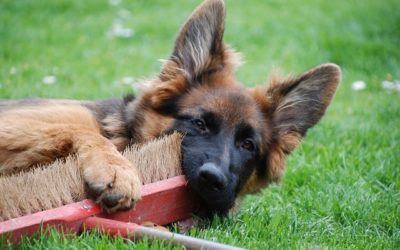German Shepherds are dogs that can be loyal friends to both humans and other dogs, especially if your German Shepherd and the other dog have established a close bond. This wonderful breed will be protective of both their human and dog friends, and that bond that will both astound and amaze you. True to their nature they love to keep their ‘flock’ close by.
However, there are times when your German Shepherd might not take to another dog. If you are introducing another dog, especially a puppy, into their world, he or she might not take kindly to it, especially if they are already established as the boss and having the “run of the house.” They might view this as an invasion of territory causing fights and altercations. Ones which you’ll end up having to break up or deal with.
It can be a fearful experience for all parties involved, so it’s important to know how to deal with the situation in order to ensure that everyone is safe and happy.
If you introduce your German Shepherd to another dog at a young age, and he or she grows up around another dog, you aren’t likely to have too many issues. Your German Shepherd will get used to interacting and sharing with another dog in the house, so it won’t be a difficult transition. In fact socializing your dog in general from a young age will be beneficial. Contact your veterinarian for puppy school classes. It’s a great way to introduce your puppy in a safe environment and practice some basic training at the same time.
If you are adopting a German Shepherd who is a younger dog or an adult, make sure to ask the shelter or previous owner how he or she got along with other dogs – some dogs simply require to live in a household with no other pets, while some enjoy the company of other dogs and will embrace being in a multi-dog household.
There are several tips that you can take when introducing a German Shepherd to another dog that can help to make the adjustment a little easier for both you and your dog.
Introduce your dogs slowly
This is key for making sure that your dogs get to learn about each other – but not putting them in a room together at first is key. Hold on to your pets and let them smell each other. Then, be sure to either place them in different rooms (alternating which room, so they can get used to each others scent), or place a barrier between them so they can still see and sniff each other.
Don’t leave them alone at first
Until you are sure that there are no dangers from the two dogs being together (such as fighting, snapping, and biting), then you shouldn’t leave them along together, especially during feeding. If you have to go out, put them in different rooms so each dog will be safe.
Keep food dishes and toys separate
If one dog is territorial and wants to keep their own food and toys to themselves, make sure not to push the issue of them sharing. Just like people, dogs like to have their own property, and should be allowed.
You can definitely have a German Shepherd and another dog – and most times, the two will coexist happily together. Whether you are introducing puppies or adult dogs, however, it is important to follow safety guidelines to keep everyone happy and safe.






